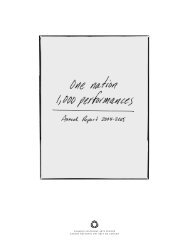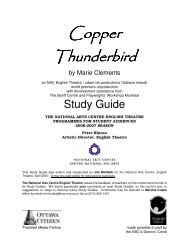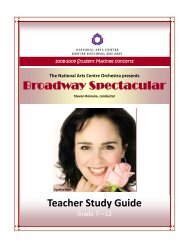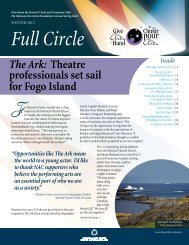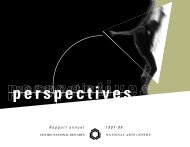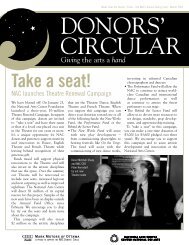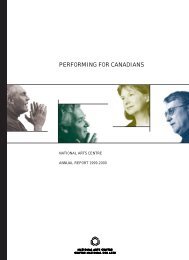NAC Annual Report 1997-1998 - National Arts Centre
NAC Annual Report 1997-1998 - National Arts Centre
NAC Annual Report 1997-1998 - National Arts Centre
- No tags were found...
You also want an ePaper? Increase the reach of your titles
YUMPU automatically turns print PDFs into web optimized ePapers that Google loves.
notes to financial statements18<strong>National</strong> <strong>Arts</strong> <strong>Centre</strong> Corporation 97-98 <strong>National</strong> <strong>Arts</strong> <strong>Centre</strong> Corporation 97-98August 31, <strong>1998</strong>Employee termination benefits> Employees of the Corporation are entitled to specified benefits on termination as providedfor under their respective contracts and conditions of employment. The liability forthese benefits is recorded as the benefits accrue to the employees.Operating expenses> Expenses relating to commercial operations and programming do not include costsrelating to building and equipment maintenance, utilities and administrative services.Pension plan> Employees of the Corporation participate in the Public Service Superannuation Plan,administered by the Government of Canada. Contributions to the Plan are required byboth the employees and the Corporation on an equal basis. The Corporation’s contributionsrepresent the total pension obligation of the Corporation. Contributions inrespect of current service are expensed during the year in which service is rendered.> The Corporation is not required under present legislation to make contributions withrespect to employees for actuarial deficiencies of the Public Service SuperannuationAccount.1. Authority, objectives and operations> The <strong>National</strong> <strong>Arts</strong> <strong>Centre</strong> Corporation (the “Corporation” or the “<strong>Centre</strong>”) was established in1969 pursuant to the <strong>National</strong> <strong>Arts</strong> <strong>Centre</strong> Act and is not subject to the provisions of the IncomeTax Act. Pursuant to Section 85 (1) of Part X of the Financial Administration Act, Divisions I toIV of Part X do not apply to the Corporation.> The objectives of the Corporation are to operate and maintain the <strong>National</strong> <strong>Arts</strong> <strong>Centre</strong>, todevelop the performing arts in the <strong>National</strong> Capital Region, and to assist the Canada Councilin the development of the performing arts elsewhere in Canada.> In furtherance of its objectives, the Corporation may arrange for, and sponsor performing artsactivities at the <strong>Centre</strong>; encourage and assist in the development of performing arts companiesresident at the <strong>Centre</strong>; arrange for, or sponsor radio, and television broadcasts and the showingof films in the <strong>Centre</strong>; provide accommodation at the <strong>Centre</strong>, on such terms and conditions asthe Corporation may fix, for national and local organizations whose objects include the developmentand encouragement of the performing arts in Canada; and, at the request of theGovernment of Canada or the Canada Council, arrange for performances elsewhere in Canadaby performing arts companies, whether resident or non-resident in Canada, and arrange for performancesoutside Canada by performing arts companies resident in Canada.> With a view to achieving the objectives, the Government of Canada has leased without chargethe <strong>National</strong> <strong>Arts</strong> <strong>Centre</strong> building complex to the Corporation. The lease is being renewed on ayearly basis. The Corporation is responsible for the operation and maintenance of the building.2. Significant accounting policiesShort-term investments> Short-term investments are valued at the lower of cost and market value.Parliamentary appropriation> The Government of Canada provides funding to the Corporation. The portion of theParliamentary appropriation used to purchase depreciable capital assets is recorded as deferredcapital funding and amortized on the same basis and over the same periods as the related capitalassets. The remaining portion of the appropriation is recorded on the statement of operations.> The parliamentary appropriation approved for the period from April 1 to August 31, is inrespect of the Government of Canada’s fiscal year ending on March 31 of the following year.Accordingly, the portion of the amount received to August 31, which is in excess of 5/12thsof the appropriation, is deferred to the following year. Similarly, the portion of the amountreceived to August 31, which is less that 5/12ths of the appropriation, is recorded as areceivable.> Differences in parliamentary appropriation received for payments in lieu of taxes tomunicipalities and other taxing authorities and the related expense for the year are recordedas either a deferred credit or an account receivable as appropriate.Inventories> Inventories are valued at cost for restaurant supplies, food and beverages.Programmes in progress> Direct costs, including advances to performing companies and artists related to programmes(shows) that will be held after year-end, are deferred, and are charged toexpenses in the year in which the programmes take place.Capital assets> Capital assets are recorded at cost net of accumulated amortization. Amortization iscalculated using the straight-line method, over the estimated useful lives of the assetsas follows:Equipment2 to 10 yearsComputer software and hardware3 to 5 yearsLeasehold improvements10 yearsDeferred revenue> Revenue from tickets sold related to programmes (shows) that will be held after yearendare deferred, and are recognized as revenue in the year in which the programmes takeplace.Contributions> The Corporation follows the deferral method of accounting for contributions.> Contributions externally restricted, and related investment income, are deferred and recognizedas revenue in the year in which the related expenses are incurred. Unrestrictedcontributions are recognized as revenue when received.3. Change in accounting policy> Prior to <strong>1998</strong>, the funding received from the Government of Canada was recorded asequity. Effective September 1, <strong>1997</strong>, the portion of the parliamentary appropriationused to purchase depreciable capital assets is now recorded as deferred capital fundingon the balance sheet, in order to conform to Canadian Institute of CharteredAccountants (CICA) Public Sector Accounting and Auditing Board recommendationson Accounting for Government Assistance, and are amortized on the same basis andover the same periods as the related capital assets. This change in accounting policy hasbeen applied retroactively and the financial statements of prior years have been restated.The effect of this change in accounting policy is a reduction in equity and an increasein deferred capital funding on the balance sheet of $7,664,998 (<strong>1997</strong> - $7,773,305), andan increase in results of operations after government funding for the year of $108,307(<strong>1997</strong> - $1,717,529).4. Cash and short-term investments> The Corporation’s policy is to invest temporary excess cash in short-term deposit certificates,bonds, and commercial paper with Canadian financial institutions. As at August31, <strong>1998</strong>, cash and short-term investments include bonds and commercial paper of$1,096,794 ($4,763,193 in <strong>1997</strong>). The average yield of the portfolio was 4.25% for the yearended August 31, <strong>1998</strong> (3.46% in <strong>1997</strong>). The fair value of short-term investments approximatesthe book value due to their impending maturity.5. Accounts Receivable> In the normal course of business, the Corporation sells its products to many customers. Oneaccount represents 29% of the year-end balance (49% in <strong>1997</strong>). The fair value of accountsreceivable approximates the book value due to their impending maturity.6. Restricted cash and investments> Restricted cash and investments arise from contributions received from individuals and corporateentities for a specified purpose.7. Contributions receivable> Contributions receivable represent the unpaid portion of the $1,000,000 pledge made by theAlexei Yashin Foundation in <strong>1997</strong>-98. Related to this pledge, an amount of $200,000 wasreceived during the year. The remaining balance of the pledge is to be received in equal paymentsof $200,000 per year in each of the next four years. The fair value of contributionsreceivable at year end is approximately $730,000.8. Capital assets<strong>1998</strong> <strong>1997</strong>Accumulated Net NetCost amortization book value book valueEquipment $ 5,525,235 4,238,709 1,286,526 $ 869,155Computer softwareand hardware 3,923,842 2,398,093 1,525,749 734,986Leaseholdimprovements 27,056,134 22,203,411 4,852,723 6,169,164> Volunteers contribute a significant number of hours per year. Because of the difficultyof determining their fair value, contributed services are not recognized in these financial$ 36,505,211 28,840,213 7,664,998 $ 7,773,305statements.19



